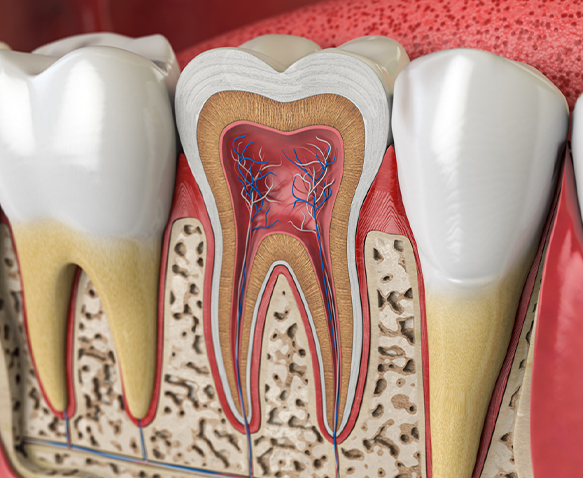1084 Main Street Holden, MA 01520
Root Canal Therapy

Root canal therapy is recommended when the nerve of a tooth becomes infected or damaged due to decay. The procedure involves removing the pulp (the soft tissue inside the tooth), nerves, bacteria, and any decayed material. The empty space is then cleaned and sealed with special, medicated dental materials to restore the tooth’s function and integrity.
Root canal treatment is often the best option to preserve a tooth that would otherwise need to be extracted. Many people mistakenly believe that simply removing a problematic tooth is the solution. However, extracting a tooth can lead to more complex and expensive issues, including problems with neighboring teeth.
Root canal treatments are highly successful and can last a lifetime, although in some cases, the tooth may need to be retreated due to a new infection.
Possible Signs That You May Need Root Canal Therapy Include:
A pimple or abscess on the gums.
Sensitivity or discomfort when exposed to hot or cold temperatures.
Intense tooth pain, especially when chewing or touching the tooth.
In some cases, there may be no noticeable symptoms at all.
Swelling or tenderness in the surrounding gums or tissues.
Reasons For Root Canal Therapy:
The decay has extended to the tooth pulp (the living tissue within the tooth).
An infection or abscess has formed inside the tooth or at the root tip.
The tooth has suffered injury or trauma.
What Does A Root Canal Procedure Involve?
Root canal treatment typically requires one or more visits and can be performed by either a general dentist or an endodontist (a specialist in root canals).
To begin, the tooth will be numbed, and a rubber dam (a thin sheet of rubber) is placed around the tooth to keep it dry and free of saliva. The dentist will then create an opening in the top of the tooth and use a series of specialized files to carefully remove the pulp, nerve tissue, and any bacteria. If there is decay present, it will also be removed using special dental tools.
After thoroughly cleaning the tooth, the dentist will seal it with either a permanent filling or, if more visits are required, a temporary filling.
During the follow-up appointment, typically a week later, the roots and inner cavity of the tooth will be filled and sealed with specialized dental materials. A filling will be placed to close the opening at the top of the tooth. To ensure the tooth’s strength and prevent it from breaking, a crown (cap) will usually be placed over the tooth. This helps restore the tooth to its full function.
Although some sensitivity may occur following treatment, it will gradually diminish as the tooth heals and any inflammation subsides.
You will receive care instructions after each visit, and maintaining good oral hygiene and attending regular dental checkups will help ensure the longevity of your root canal treatment.